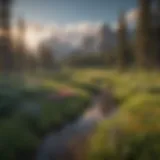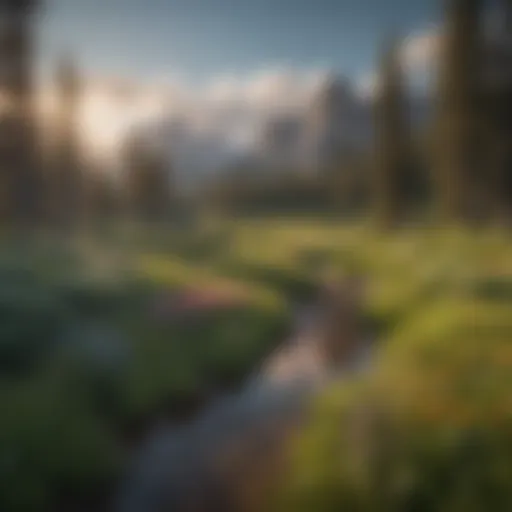Mastering Fly Patterns for Lake Trout Success
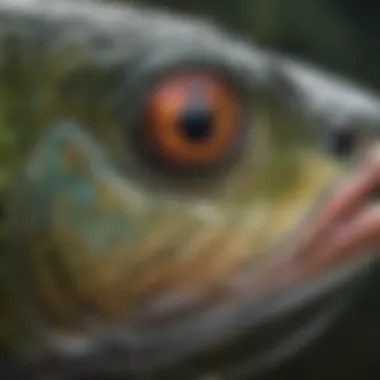

Intro
When it comes to fishing in lakes, particularly for trout, understanding the subtleties of selecting the right fly pattern can make or break your experience. This isn’t merely about tossing a line into the water and hoping for the best. Trout, with their varied diets and behaviors, respond differently depending on the time of year, water temperature, and even the presence of local flora and fauna.
In this guide, we will unravel the complexities of effective fly fishing strategies tailored for trout inhabiting lake environments. It is about tapping into that wealth of knowledge - the nitty-gritty of fly selection, the art of presentation techniques, the rhythms of seasonal variations, and the impact of ecological factors on trout behavior. Let’s dive into the essence of this angling pursuit and what makes it an art form as much as a skill.
Understanding Trout Behavior
Trout are not just passive participants in their habitat. They have their own behaviors and preferences that can be influenced by a multitude of factors. For anglers, knowing how to read these signals can be the difference between a catch and a quiet day at the lake.
- Seasonal Changes: The time of year greatly influences trout behavior. During spring, for example, they can be more aggressive, feeding heavily as they prepare for spawning. In summer, they may seek cooler waters. Understanding these seasonal variations can guide your fly selection and fishing tactics.
- Water Conditions: Factors such as clarity, temperature, and flow can alter where trout will be found and what they will be eating. In murkier waters, fluoresent and larger patterns may be more successful as they grab the fish's attention.
- Local Flora and Fauna: A healthy ecosystem has its own set of food sources that influence trout behavior. What insects are hatching? Are there any baitfish present? This information is crucial, as it directs anglers to mimic local prey with their fly choices.
Understanding the Lake Ecosystem
Understanding the lake ecosystem is like peering into the intricate machinery of nature. For anyone looking to enhance their trout fishing skills, comprehending this ecosystem isn't just a good idea—it's essential. Trout don’t exist in a vacuum; they’re deeply intertwined with their environment, which consists of a tapestry of biological and physical elements. Recognizing these factors can significantly improve an angler's chances of success by allowing them to predict trout behavior and make well-informed choices about fly patterns.
Types of Lakes and Their Characteristics
Lakes can be categorized in various ways—each type offers unique features that influence trout populations. Two primary classifications are natural and artificial lakes.
Natural lakes, formed through glacial, volcanic, or tectonic activity, typically have more diverse ecosystems. For instance, a glacial lake often has crystal-clear waters and cold temperatures—ideal for species like lake trout, which thrive in cooler environments.
In contrast, artificial lakes, created by human construction, can have a different set of dynamics. These often fluctuate in temperature and clarity due to run-off and human influence, leading to trout that may adapt differently. A hands-on example of this is the Lake Hartwell, where the fluctuation of water levels in summer can change where trout are found, making understanding these characteristics vital.
Role of Flora and Fauna
The flora and fauna in these ecosystems are not mere backdrop; they play a pivotal role in trout survival and behavior. Aquatic plants, like eelgrass and coontail, provide crucial habitats and breeding grounds, while invertebrates, such as mayflies and caddisflies, serve as primary food sources. The lush greenery isn’t just for show; it creates oxygen through photosynthesis, supporting fish life.
Interestingly, various species of fish can indicate the health of the lake ecosystem. For instance, the presence of natural baitfish, such as minnows, often signals a thriving environment where trout can flourish. If one were to observe a lake and see these elements in harmony, it bodes well for a successful fishing day.
Impact of Water Temperature and Clarity
Water temperature and clarity can be make-or-break factors in fishing. Trout are ectothermic; meaning their body temperature depends on their surroundings, which directly influences their metabolic rate and activity level. Ideal temperatures generally hover around 50 to 60 degrees Fahrenheit. When water temps spike in summer, trout tend to seek cooler depths, often lurking near submerged structures; understanding this dynamic is crucial.
Clarity is another key factor. Clear water allows more light penetration, impacting both aquatic plant growth and the visibility for fish. Trout in clearer waters will often be more skittish and selective about their feeding habits. Thus, knowing how these elements affect trout movement can help anglers choose appropriate fly patterns and presentation techniques that align with current conditions.
"The ecosystem is not just a stage; it’s an interconnected web. Every element plays a role in the grand performance of life beneath the surface."
In essence, a comprehensive grasp of the lake ecosystem provides a solid foundation for any angler. Once the dynamics between water characteristics, flora, and fauna are understood, the pathway to selecting the right flies and fishing techniques becomes clearer. With this knowledge in hand, the art of fishing can transition from mere luck to a calculated strategy, enhancing both enjoyment and success on the water.
Trout Species in Lakes
Understanding the various trout species inhabiting lakes is essential for anglers aiming to improve their success rate during fishing expeditions. Trout can exhibit distinctly different behaviors, feeding strategies, and preferred habitats based on their specific species, which directly influences the types of flies one should use. Moreover, being aware of these species helps build a solid foundation for knowing when and how to fish effectively in lake environments. By providing insight into the characteristics of various trout species, anglers can fine-tune their tactics, ensuring that they select flies that resonate with the trout’s natural instincts.
Common Trout Species Found in Lakes
In many lakes across North America and beyond, there are several trout species that stand out. Each type has its own quirks and preferences:
- Rainbow Trout: Recognizable by their vibrant colors, rainbow trout are often found in both cold and warm waters. They tend to thrive in lakes with ample vegetation and can be quite opportunistic feeders.
- Brown Trout: These fish are typically more secretive and can be found lurking in deeper waters. Their feeding habits can shift dramatically depending on the time of year, making them a bit tricky to target.
- Lake Trout: Mostly residing in colder, deeper waters, lake trout are favorites among anglers fishing in larger lakes. They often hunt near the bottom, making depth proficiency key to successful fishing.
- Brook Trout: This is a smaller species, usually found in more remote and lesser-trafficked waters. Their habitats often overlap with those of rainbow trout but may differ significantly in size and feeding behavior.
Understanding characteristics such as these can dramatically increase your chances of catching fish. Each species has unique feeding times, so knowing your target trout type helps determine the best times to fish.
Behavioral Patterns of Lake Trout
Lake trout are fascinating creatures whose behavior can be influenced by a variety of environmental factors. They are known to exhibit a highly stratified lifestyle:
- Temperature Regulation: Lake trout prefer cooler waters and often seek out depths where the temperature remains stable. As seasons change, they may move vertically in the water column to find these ideal conditions.
- Nocturnal Activity: Unlike some trout that may feed during the day, lake trout often show increased activity at dawn and dusk. Their feeding patterns align with the behaviors of their prey, which can include smaller fish or invertebrates that are also active during these times.
- Territorial Nature: During spawning season, these trout can become aggressive and territorial. This leads to increased activity levels, creating opportunities for anglers who know when to target their habitats.
By keeping these behavioral traits in mind, anglers can better strategize their approaches. The more you understand how these fish act at different times of the year, the better your odds of landing one.
Feeding Habits Throughout Seasons
Trout feeding habits shift noticeably with the seasons, influenced by water temperature and food availability. Here's a closer look:
- Spring: As the ice melts and water warms, trout emerge with increased appetites. They often feast on emerging insects and other small organisms. Flies during this season should mimic these natural food sources like mayflies or caddisflies.
- Summer: The hot weather poses challenges; trout tend to seek refuge in cooler, deeper waters where they can find their prey. Summer flies should reflect the aquatic insects and baitfish active in the water.
- Autumn: Trout start preparing for winter, becoming more aggressive feeders. They go after larger food sources to build fat reserves. Streamers or larger flies can be particularly effective during this season.
- Winter: Fishing during winter can be tricky, as trout become lethargic in colder waters. Here, a dead drift with small, subtle flies often proves to be the best approach.
Selecting the Right Flies
Choosing the right flies is essential for successful trout fishing in lakes, as it influences not only the catch rate but also the overall experience on the water. A well-selected fly can make all the difference between a slow day and a bucket filled with trout. When anglers match their fly selection to the specifics of the lake ecosystem, they heighten their chances of enticing strikes. In this section, we’ll explore key attributes that make flies effective, how to match them to the current hatch, and highlight popular patterns that resonate with lake trout.
Key Attributes of Effective Flies
When selecting flies for fishing, several key attributes should be considered:
- Size: The dimensions of the fly should approximate the natural prey found in the lake. If trout are feeding on smaller insects, using a small fly can yield better results.
- Color: Colors attract different species and mimic various prey. Bright patterns may stand out in murky waters, while muted tones can be more effective in clear lakes.
- Action: The way a fly behaves in the water can often provoke a trout’s curiosity. Flies that create natural movements can mimic the erratic behavior of injured insects or baitfish.
- Material: Different materials create different visuals and textures. Using feathers, fur, and synthetic fibers can give flies a lifelike appearance.
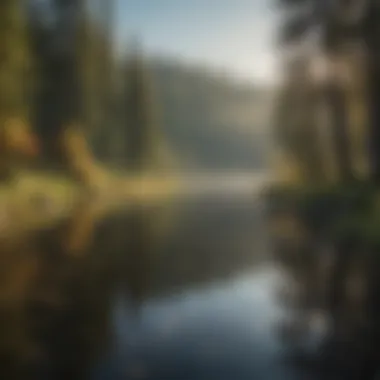

Understanding these attributes helps anglers make informed choices, ensuring successful prospects while on the water.
Matching the Hatch
Matching the hatch is a well-known principle in fly fishing. This entails selecting flies that closely resemble the insects or organisms currently populating the water. Trout are often selective feeders, and their preferences can shift with the seasons.
To effectively match the hatch, consider the following:
- Observation: Keep an eye on what’s hatching. Look for flying insects or surface activity. Sometimes, watching the water can tell you a lot about what’s available for trout.
- Timing: Insects hatch at specific times, depending on the season and environmental conditions. Early mornings or late afternoons are prime times to witness this phenomenon.
- Adaptability: Be prepared to switch flies if the trout aren’t biting. Sometimes they can be finicky based on what else is happening around them.
By paying attention to the natural food sources, one can efficiently increase fishing success. Take, for example, a late spring hatch of mayflies; choosing a size 16 dry fly resembling these can entice hungry trout willing to rise to the surface.
Popular Fly Patterns for Lake Trout
Various fly patterns have gained popularity among anglers targeting lake trout. Here are a few that often prove effective:
- Woolly Bugger: This versatile fly works wonders in many situations. Its marabou tail and palmered hackle create the illusion of movement and can imitate both baitfish and large nymphs.
- Zonker: A streamer pattern that mimics a wounded baitfish. The long strip of fur used gives it an undulating motion, capturing the eye of predatory trout.
- Clouser Minnow: Renowned for its ability to dive and escape, the Clouser is effective at attracting lake trout at various depths.
- Parachute Adams: When fishing for rising trout, this dry fly resembles several types of insects. It floats well and is easy to spot on the water’s surface.
Fishing with these patterns can improve your likelihood of a successful catch. Don’t forget about local variations or any need to adjust colors and sizes based on water conditions. Remember: when it comes to fly fishing, knowledge truly is power.
Techniques for Presenting Flies
The art of presenting flies effectively is paramount in the pursuit of trout in lakes. This aspect can truly turn an average fishing experience into a successful one. With the right techniques, anglers can mimic natural movements that entice trout to strike. Not only do successful presentations increase catch rates, but they also enhance overall fishing enjoyment. It’s about understanding how trout react to different stimuli in their environment and adapting accordingly.
Casting Techniques for Lake Fishing
Roll Cast
The roll cast is an essential tool in a fly fisherman's kit. This technique shines in situations where backcasting space is limited—think overhanging trees or steep banks. It allows for a smooth presentation while keeping the line low to the water’s surface. The key characteristic here is its ability to deliver flies quietly, minimizing disturbance and keeping wary trout at ease.
While ease of use is a notable advantage, the roll cast does have its limitations. It may not offer the distance that an overhead cast can, which could be a drawback when trying to cover a larger area.
Overhead Cast
The overhead cast is probably the most recognized casting technique among anglers. Its strength lies in the ability to cover extensive distances and launch flies straight into the heart of feeding trout. This method relies on a precise arm movement, pulling the line back and flipping it forward. If a fisherman has a background in traditional fishing methods, the overhead cast will feel quite familiar.
It's worth mentioning that while it boasts significant distance capabilities, an overhead cast can create splashes and disturbances, which might spook the fish. Thus, employing it in the right environment is crucial.
Sidearm Cast
The sidearm cast is a versatile technique that many anglers don’t fully appreciate. It’s particularly effective when fishing in windy conditions, as the lower angle helps avoid wind interference. Moreover, this cast can be beneficial for ensuring stealthy presentations near structures, like submerged logs or rock piles.
A prominent benefit of the sidearm cast is that it allows for intricate maneuvering around obstacles without risking snagging gear. However, it can be less effective for achieving distance compared to the overhead cast, which is a consideration for anglers aiming to reach further spots.
Retrieve Methods for Trout Flies
Strip Retrieve
The strip retrieve is unapologetically straightforward yet incredibly efficient. The angler pulls the line in quick, short movements to simulate the action of a struggling baitfish. This method is particularly effective in luring aggressive trout.
The key characteristic of this technique is its responsiveness; it lets the fisherman adjust the speed easily based on the trout’s reactions. However, it’s not without its downsides, as it requires constant attention and can leave less time for enjoying the surroundings.
Twitch Retrieve
The twitch retrieve resembles a dance between the angler and the fish, where the line is pulled and then immediately released to create an enticing jerking motion. This method captures the attention of trout looking for an easy meal. The distinctive feature here is how it mimics injured or distressed prey, which can be irresistible to trout.
Although very effective, it requires a certain finesse and might feel unnatural to beginners. The angler must strike a balance between the twitch and letting the fly drift naturally, which can be tricky at times.
Dead Drift
The dead drift technique is all about patience. Here, the fly is allowed to float naturally with the current, as if it were an unsuspecting insect. This approach thrives on the trout’s instinct to strike at anything that seems easy to catch.
The beauty of the dead drift lies in its simplicity; there’s minimal effort required once the fly is positioned correctly. Nevertheless, maintaining a proper drift is vital and can often be challenging, especially in turbulent waters.
Depth Proficiency and Tactics
Understanding water depth is key when pursuing trout in lakes. Different trout species often inhabit specific layers of water depending on the time of year, temperature, and available food.
Having a grasp on underwater topography also helps in locating prime fishing spots. Using sonar technology or fish finders can give anglers an edge, but old-school techniques like observing natural insect hatches or water currents also serve well.
Ultimately, optimal depth fishing combines knowledge of local ecosystems with adaptability in presentation methods.
"Knowing the water depth and adapting your techniques is half the battle won in lake trout fishing."
By mastering these techniques, anglers can significantly enhance their lake trout fishing experiences.
Seasonal Strategies for Fishing
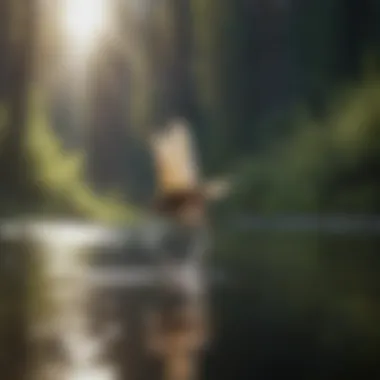

Understanding seasonal strategies is key to maximizing your trout fishing experience in lakes. Trout behavior changes significantly with the seasons due to factors like temperature, food availability, and spawning cycles. Tailoring your approach based on these seasonal shifts can greatly enhance your effectiveness on the water. Being mindful of the specific characteristics of each season helps anglers make informed decisions about fly selection, presentation techniques, and timing. In this section, we explore the unique opportunities each season presents, so you can adapt and refine your fishing tactics to align with the trout's natural behavior.
Spring Approaches to Trout Fishing
As winter’s chill fades, spring is a critical time for trout fishing. The warming water tempts trout to become more active, increasing their feeding patterns. This is the season for anglers to focus on what’s happening above and below the surface.
In springtime, you’ll find insects like mayflies, caddisflies, and stoneflies starting to emerge. These hatches can attract trout into shallower waters as they search for food. Employing dry flies and nymphs that mimic these insects proves effective. Playing around with sizes can also yield better results, as the hatch can vary.
- Key Tips:
- Use a strike indicator to detect subtle takes.
- Start your day early because trout are often more active at dawn.
An important consideration this season is the trout's spawning behavior. Depending on the species, trout may be spawning in shallow gravel beds during late spring, making them more skittish. Adjusting your fishing tactics can help avoid spooking these fish.
Summer Fishing Techniques
Summer heats up both the weather and trout activity—though high temperatures can pose challenges. During this season, you might find trout holding in cooler, deeper waters during the hottest parts of the day. Early mornings and late evenings are prime time for fishing, as trout venture out to feed when temperatures are more bearable.
During summer, focus on using more streamer patterns and larger dry flies to capture the trout’s attention. The presence of baitfish can be significant this season, so try incorporating woolly buggers or other streamers that imitate these hungry morsels. Additionally, watch for surface activity; a well-placed dry fly can trigger explosive strikes from rising fish.
- Top Tactics:
- Adjust your depth with weighted lines if trout retreat to deeper waters.
- Consider using terrestrial patterns, like ants or grasshoppers, especially in late summer.
Autumn Insights and Recommendations
The crisp air of autumn signals a transforming lake ecosystem. As water temperatures drop, trout seem to engage in a final feeding frenzy, preparing for winter. This is perhaps one of the most exciting times to fish.
In autumn, look for trout to be less picky as they bulk up. Use larger flies that mimic the abundant baitfish or crayfish. An effective strategy involves a mix of streamers and dead-drifted nymphs to appeal to trout’s diverse dietary needs as they take advantage of last chances to feed before colder weather sets in.
- Considerations:
- Pay attention to fall foliage—underwater hideouts formed by submerged leaves can provide great shelter.
- Plan for changing weather; cloudy days often trigger increased feeding activity.
Winter Challenges and Solutions
Winter fishing can feel like a battle of wills against the elements. However, determined anglers can still find success, provided they adapt their strategies to the colder conditions. During this time, trout behavior slows, resulting in decreased feeding activity.
Fish tend to seek warmer water locations, considering inflows or deeper pools can be hotspots. Using smaller flies, like midges or tiny nymphs, can be crucial as trout may only prefer more subtle offerings in the frigid temps. (Thin lines) will help prevent line freeze at lower temperatures.
- Effective Approaches:
- Opt for slow retrieves to present your flies effectively in still water.
- Fishing during the warmest part of the day can increase chances of success.
"Fishing in winter demands patience, but the rewards can be significant for those willing to brave the cold."
In summary, seasonal strategies in trout fishing are imperative for understanding where and when to fish, and what patterns or techniques to use. Each season presents distinct opportunities and challenges that can be navigated with observation and adaptability.
Environmental Considerations
When we talk about trout fishing in lakes, it’s necessary to take a closer look at environmental considerations. The interplay between human activities and natural ecosystems can shape the fishing experience, and thus understanding these dynamics is key for any angler aiming for success. Every aspect of an ecosystem affects the behavior of trout, making it essential for fishing enthusiasts to acknowledge their environmental footprint. In doing so, it enables fishing practices that are not only effective but sustainable over the long haul.
Impact of Human Activity on Lake Ecosystems
Human activities have historically influenced lake ecosystems in various ways. Urbanization, agriculture, and industrial practices create direct and indirect pressures on these ecosystems.
- Pollution: Runoff from agricultural fields introduces fertilizers and pesticides into lakes, increasing nutrient levels and potentially leading to algal blooms. These blooms can deplete oxygen levels, making it hard for trout to thrive.
- Habitat Destruction: Deforestation and land development reduce the natural cover and essential breeding grounds for trout. More exposed shorelines can lead to increased heat in the water, which is detrimental during hot months.
- Overfishing: Intensive fishing practices, including illegal netting and the use of harmful fishing techniques, can deplete trout populations.
It’s crucial for anglers to be mindful of these impacts. A thoughtful fisher can help mitigate these problems by practicing catch-and-release methods and ensuring they don’t contribute to pollution.
Conservation Practices for Sustainable Fishing
Implementing sound conservation practices is fundamental to ensuring sustainable fishing. This not only preserves trout populations but also promotes overall health of lake ecosystems. Some effective strategies include:
- Adhering to Regulations: Following local fishing regulations regarding limits on catch sizes and seasons prevents overharvesting.
- Participating in Clean-up Activities: Engaging in local conservation efforts can make a notable difference. Picking up trash and controlling invasive species helps maintain the natural balance.
- Monitoring Water Quality: Keeping tabs on water quality can inform anglers about potential hazards for trout. Low oxygen levels or high temperatures can forewarn of tough fishing days ahead.
Practicing sustainable fishing doesn't just benefit the fish; it also leads to better fishing experiences in the long run.
Exploring Native vs. Non-Native Species
The introduction of non-native species into lakes presents unique challenges. Understanding the interaction between native and non-native species is necessary for optimizing trout fishing practices.
- Native Species: They have evolved alongside local flora and fauna, creating a balanced ecosystem that supports a variety of life, including trout. Maintaining this balance is essential for the continued success of trout fishing.
- Non-Native Species: Non-native fish can compete with native trout for food and space, sometimes resulting in significant declines in trout populations. For instance, striped bass introduced into some lakes have been known to impact local trout counts negatively.
Educating oneself about these dynamics can assist anglers in choosing the right flies and tactics tailored to their specific local lake environments.
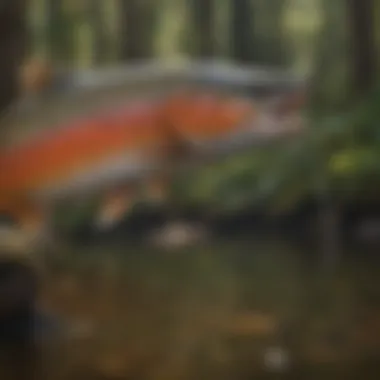

"By understanding and respecting the environment, anglers can fish in a way that sustains ecosystems for generations to come."
Advanced Techniques and Tools
In understanding the complex dynamics of trout fishing in lakes, the importance of employing advanced techniques and tools cannot be underestimated. These instruments, ranging from technological innovations to specific gear selections, play a crucial role in maximizing your effectiveness on the water. By integrating knowledge of these advanced methods into your fishing repertoire, you not only enhance your fishing experience but also increase your chances of landing that elusive catch.
Fly Tying Techniques for Specific Patterns
Crafting effective flies is an art and a science, requiring an understanding of both the fish's behavior and the patterns they seek during various conditions. When tying flies for lake trout, focus on replicating their natural prey. Good practices in fly tying include:
- Choosing the Right Materials: Use feathers, furs, and synthetics that mimic the texture and appearance of the organisms in the lake.
- Size and Coloration: Always adapt the size and color of your flies to match the local flora and fauna. Trout tend to be picky, so using the right tones can make a difference.
- Design Specific Patterns: Popular designs such as the woolly bugger or the clouser minnow can be tied in various colors and sizes to optimize effectiveness.
Utilizing Technology in Fishing
Technology has come a long way in the world of fishing, offering tools that help make more informed decisions on the water. Here's a look at three important technological aids:
Fish Finders
Fish finders are invaluable in the lake fishing toolkit. These devices use sonar to detect fish and structure beneath the water surface. The key characteristic of fish finders is their ability to display underwater images in real-time, allowing anglers to locate trout hiding in deep waters or near structures. Their unique feature—the ability to differentiate between species—helps pinpoint trout-rich areas, providing a distinct advantage.
However, one must be cautious with reliance on technology, as overdependence can lead to a lack of traditional fishing skills. Additionally, some fish finders can be expensive and require learning, so the benefits should be weighed against these disadvantages.
Weather Apps
Weather apps have revolutionized how anglers plan their outings, providing crucial information such as temperature, barometric pressure, and wind conditions. These apps serve as key elements in predicting fish activity, as trout respond to weather changes, particularly in terms of feeding. The unique feature of these applications is that they can offer hyper-local forecasts, which allow anglers to understand specific conditions at their chosen lakes.
Nevertheless, relying solely on predictive technology may lead to missed opportunities if conditions shift unexpectedly. For best results, combine these insights with direct observation on the water.
Water Quality Monitoring
Water quality monitoring is an often-overlooked aspect of successful trout fishing. Being aware of the chemical composition of the water, including pH levels and turbidity, can affect trout behavior greatly. Understanding the key characteristic of water quality allows anglers to assess potential hotspots for trout based on their habitat needs. Furthermore, unique monitoring tools provide real-time data that can indicate when to fish or when to avoid certain areas due to poor water quality.
On the downside, water testing can be cumbersome and requires proper equipment. Moreover, it may not always present immediate results when planning fishing trips.
Choosing the Right Gear and Equipment
Equipping yourself with the right fishing gear is fundamental. It ensures not only your comfort on the water but directly influences your fishing efficacy.
Rods and Reels
The choice of rods and reels should prioritize balance and sensitivity. A flexible rod enables better action, while a precision reel can ensure smooth retrieval. These components work in tandem—the key characteristic being how well they minimize line twist and maximize control over the fly. This combination allows for more accurate casting, which is vital in lake trout fishing.
However, higher quality gear can also come at a premium price, thus requiring anglers to consider their budget versus the benefits of performance.
Lines and Leaders
Selecting the right lines and leaders is equally important as it impacts your ability to present flies effectively. There are floating, sinking, and intermediate lines available, depending on where you anticipate the trout will be. The key characteristic of lines is their ability to manage drag and maintain a natural movement of the fly. Matching the right leader material to your line further enhances your presentation.
Based on your fishing technique, having too heavy or light of a line could sabotage your chances. Make informed decisions about what suits your style best.
Lures and Accessories
Accessories ranging from nippers to floatants play a significant role in preventing snags and ensuring effective applications of the flies. The key characteristic of using specific lures is that they can trigger trout’s predatorial instincts when presented correctly. Familiarizing yourself with accessories available in the market can lead to enhanced experiences.
Nonetheless, too many accessories can create clutter and distraction, leading to confusion about what to use in varying situations. Streamline your approach for best results.
Ultimately, cultivating an understanding of how these tools complement your fishing skills can lead to a richer, more fulfilling experience in lake trout fishing.
Final Thoughts
Understanding effective fly patterns for trout fishing in lakes is not merely a technical exercise, but rather a holistic approach that combines ecological knowledge, applicable skills, and a passion for the environment. This article underscores the importance of various strategies and considerations that come into play when pursuing trout in these unique aquatic ecosystems. By synthesizing diverse insights—from the specifics of fly selection to the influence of seasonal changes—anglers can enhance their fishing success and foster a greater appreciation for our lakes.
Continuous Learning and Adaptation
Adapting to changing lake conditions and trout behavior is vital for anyone serious about angling. Continuous learning is the backbone of proficiency in fishing. It’s essential to remain informed about the evolving dynamics of the lakes you frequent. Each fishing season can show a notable difference; for example, water clarity can shift dramatically based on rainfall, affecting how trout perceive and engage with flies. Seasonal adjustments in trout feeding patterns also demand flexibility in chosen tactics. Anglers should regularly seek knowledge from reputable sources, such as research articles, local fishing reports, or even seasoned anglers in forums like reddit.com.
There are numerous ways to promote your learning:
- Join Workshops: Participate in camps or classes about fly tying and water ecology.
- Follow Online Tutorials: Platforms offering videos on fishing techniques can provide valuable practical insights.
- Engage with Local Experts: Spend time with local professionals—learning from their experiences can provide shortcuts to mastering skills.
With each new technique or principle learned, improvements can be made to your approach, ensuring adaptability and sustained success regardless of external conditions.
Joining Community and Networking Opportunities
Engagement in the fishing community can broaden one's horizons immensely. Networking with other fishing enthusiasts opens doors to shared knowledge, access to local fishing spots, and perhaps even joint outings that enhance the overall experience. Communities, whether online or local, present a unique opportunity to discuss effective fly patterns and techniques, contributing to a richer understanding of the sport.
Consider the following avenues to integrate into these networks:
- Fishing Clubs: Membership in local clubs can lead to structured events that foster skill-building.
- Social Media Groups: Platforms like Facebook host groups focused on fly fishing where enthusiasts swap tips and experiences.
- Forum Discussions: Engaging in discussions on platforms like reddit.com allows for real-time advice on regional fishing conditions and successes.
“The best lessons often come from those whose shoes you've never walked in.”
By immersing yourself in the community, not only can fishing techniques be refined, but the overall enjoyment and connection with the sport and environment can also be significantly heightened. Ultimately, forming these connections fosters a culture of support and collective growth, ensuring the future of fishing traditions continues in a sustainable fashion.
